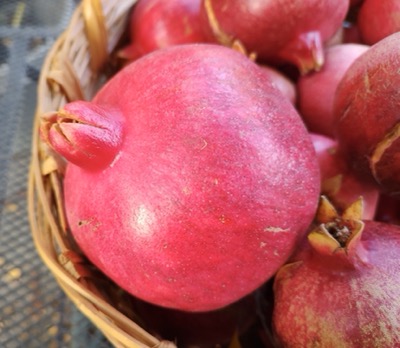Tips for when to harvest and how to seed without mess


It’s a good year for pomegranates in the Sacramento region. Debbie Arrington
It’s pomegranate harvest time. And if you haven’t already, you should probably bring in your fruit.
Pomegranate trees tend to soak up moisture – and rain is forecast for most of this week. Trees will pump all that extra water into their fruit, causing pomegranates to split their skin.
Most commercial growers pick pomegranates when they’re under-ripe to avoid splitting or other damage. When the round fruit turns blocky, the arils (the seed sacs) are at their juiciest and sweetest. That’s the best time to pick – when the fruit is at its peak. And that’s right now – early to mid November.
Judging by my own Wonderful pomegranate (the most common variety), this is a good year for pomegranates. My fruit are huge, including one that topped 2 pounds. Long before they started showing signs of over-ripeness, my pomegranates were under attack from birds and squirrels. (That's another clue they’re ready to pick.)
Off the tree, pomegranates will keep for several weeks. In the refrigerator crisper, they'll last three months or more. They'll actually produce more juice after they've sat for a couple of weeks.
By that time, the leathery skin can start to harden. If so, soak the whole fruit for 5 to 10 minutes in lukewarm water before seeding. That soaking also will remove any grit or soot the fruit may have collected during its long hang time on the tree.
Depending on size, pomegranates contain anywhere from 200 to 1,200 arils. Those juicy little seed sacs are what you want, whether to be eaten whole fresh or squeezed.
How do you seed a pomegranate without making a mess? Do it under water. Fill a large bowl with water. With a sharp paring knife, score the fruit around the calyx – the little cup-like structure on the blossom end of the fruit – and remove it. Then gently score the sides from the stem end to the blossom end. Holding the fruit under water, gently pull the sections apart. Then, tease out the arils into the water. Any pulp will float to the surface, where it can be skimmed off. Once all the seeds are removed, drain the bowl into a sieve.

Did your pomegranate have an off year with little or no fruit? The next question: When did you prune?
Hard pruning of a pomegranate tree can lead to a season with no fruit. Pomegranates bear fruit on second-year wood – shoots the tree produced the previous year. If you remove all the new growth each winter, the pomegranate will have few if any fruit.
Instead, prune lightly in January after the shrub has dropped its foliage, concentrating on opening the center of the plant for good air circulation.
As a Mediterranean fruit, pomegranates do very well in our climate. Once established, they’re relatively drought tolerant, too. They’re a beautiful edible ornamental shrub (yes, they’re actually a multi-trunked shrub, not a true tree) with glossy leaves, bright orange flowers, gorgeous red fruit and golden fall foliage.
For more tips on pomegranates: https://www2.ipm.ucanr.edu/agriculture/pomegranate/.